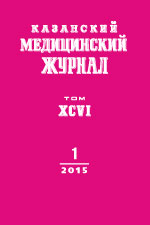Клиническая картина и лечение острых кишечных инфекций у детей на современном этапе
- Авторы: Шаджалилова М.С.1
-
Учреждения:
- Ташкентский педиатрический медицинский институт, Узбекистан
- Выпуск: Том 96, № 1 (2015)
- Страницы: 37-42
- Раздел: Теоретическая и клиническая медицина
- Статья получена: 28.03.2016
- Статья опубликована: 15.02.2015
- URL: https://kazanmedjournal.ru/kazanmedj/article/view/1486
- DOI: https://doi.org/10.17750/KMJ2015-037
- ID: 1486
Цитировать
Полный текст
Аннотация
Цель. Изучение клинической картины и лечения острых кишечных инфекций у детей раннего возраста на современном этапе.
Методы. Объектом исследования было наблюдение за 225 детьми в возрасте от 4 мес до 3 лет. По специально разработанным картам изучали семиотику и динамику клинического течения инфекционного процесса, характер и тип поражения пищеварительной системы, эффективность проводимой терапии. Для определения этиологии возбудителей острых кишечных инфекций применяли бактериологический, микробиологический, иммунологический и генетический методы. Для построения модели и проведения факторного анализа был использован метод главных компонент. Оптимальное количество выделяемых факторов было определено с учётом критериев Кайзера, «Scree-test» и степени полноты факторизации.
Результаты. Клиническая картина кишечных инфекций у всех детей была чётко выраженной. Болезнь протекала в типичной форме, у 63 (28,0%) больных возникали обострения. Заболевание протекало преимущественно по типу гастроэнтероколита, преобладали среднетяжёлые формы заболевания (у 167 детей, 74,2%). Тяжёлые формы острых кишечных инфекций отмечены у 58 (25,8%) детей с развитием токсикоза и эксикоза III степени. Преморбидный фон у всех (100%) детей отягощён сопутствующими заболеваниями. Этиологический диагноз был установлен у 77,6% больных. Следует учитывать, что кишечная инфекция и её лечение антибактериальными средствами в 100% случаев приводят к развитию дисбактериоза кишечника различной степени тяжести и могут стать причиной ассоциированной с антибиотиками диареи, обусловленной Clostridium difficile.
Вывод. В структуре общего факторного влияния на исходное состояние детей с острыми кишечными инфекциями наиболее значимыми факторами оказались длительность гипертермии, болевой синдром, состояние кишечной палочки с нормальной ферментативной активностью, этиологический фактор и условно-патогенная флора кишечника; при лечении наибольшая эффективность отмечена у гентамицина, а в случаях среднетяжёлого и тяжёлого течения заболевания - у цефтриаксона.
Ключевые слова
Об авторах
Мукаррам Салимджановна Шаджалилова
Ташкентский педиатрический медицинский институт, Узбекистан
Автор, ответственный за переписку.
Email: goodoctor11@mail.ru
Список литературы
- Асилова М.У. Диарея у детей: диагностика, клиника, лечение и профилактика // Бюлл. ассоциации врачей Узбекистана. - 2007. - №2. - С. 103-106.
- Благуш П. Факторный анализ с обобщениями. - М.: Финансы и статистика, 1989. - 248 с.
- Махмудов О.С. Современные представления об инфекционной патологии среди детей и основные направления совершенствования стратегии её профилактики в Узбекистане // Педиатрия. Ташкент. - 2000. - №2-3. - С. 146-148.
- Онищенко Г.Г. Сохранение здоровья нации - борьба с инфекционными и паразитарными заболеваниями // Эпидемиол. и инфекц. бол. - 2007. - №5. - С. 1-10.
- Циммерман Я.С. Синдром диареи: современное состояние проблемы // Клин. мед. - 2009. - Т. 87, №3. - С. 18-25.
- Causes of child mortality for the year 2010. - http://www/who.int/gho/childhealth/mortality-causesteхt/en/indeх.html (дата обращения: 14.01.2013).
- Diarrhoea: Why children are still dying and what can be done. - UNICEF/WHO, 2009. - 68 p.
Дополнительные файлы







